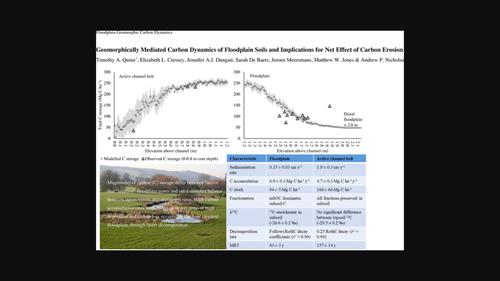当前位置:
X-MOL 学术
›
Hydrol. Process.
›
论文详情
Our official English website, www.x-mol.net, welcomes your
feedback! (Note: you will need to create a separate account there.)
Geomorphically mediated carbon dynamics of floodplain soils and implications for net effect of carbon erosion
Hydrological Processes ( IF 2.8 ) Pub Date : 2022-08-02 , DOI: 10.1002/hyp.14657 Timothy A. Quine 1 , Elizabeth L. Cressey 1 , Jennifer A. J. Dungait 1 , Sarah De Baets 1, 2, 3 , Jeroen Meersmans 1, 2, 4 , Matthew W. Jones 1, 5 , Andrew P. Nicholas 1
Hydrological Processes ( IF 2.8 ) Pub Date : 2022-08-02 , DOI: 10.1002/hyp.14657 Timothy A. Quine 1 , Elizabeth L. Cressey 1 , Jennifer A. J. Dungait 1 , Sarah De Baets 1, 2, 3 , Jeroen Meersmans 1, 2, 4 , Matthew W. Jones 1, 5 , Andrew P. Nicholas 1
Affiliation

|
The fate of organic carbon deposited in floodplain sediments is an important control on the magnitude and direction of the carbon flux from anthropogenically accelerated erosion and channelization of the riverine network. Globally, carbon deposition rates and mean residence time (MRT) within different geomorphic settings remains poorly constrained. We sampled soil profiles to 0.8 m depth from two geomorphic zones: active channel belt (ACB) and lowland floodplain, under long-term pasture adjacent to the river Culm in SW England, UK. We evaluated sedimentation rates and carbon storage using fallout radionuclide 137Cs, particle size and total carbon analyses. Variation in decomposition was assessed via empirical (soil aggregate size, density fractionation combined with natural abundance 13C analysis) and modelling simulation (using the RothC model and catchment implications explored using a floodplain evolution model). Sedimentation and carbon accumulation rates were 5–6 times greater in the ACB than the floodplain. Carbon decomposition rates also varied with geomorphic setting. In floodplain cores, faster decomposition rates were indicated by greater 13C-enrichment and subsoils dominated by mineral-associated soil organic carbon. Whereas, in the ACB, carbon was less processed and 13C-depleted, with light fraction and macroaggregate-carbon throughout the cores, and RothC modelled decomposition rates were 4-fold less than lowland floodplain cores. Including the ACB in floodplain carbon MRT calculations increased overall MRT by 10%. The major differences in the balance of sedimentation and decomposition rates between active and inactive floodplains suggests the relative extent of these contrasting zones is critical to the overall carbon balance. Restoration projects could enhance soil carbon storage by maximizing active floodplain areas by increasing river channel complexity.
中文翻译:

洪泛区土壤的地貌介导的碳动力学及其对碳侵蚀净效应的影响
沉积在漫滩沉积物中的有机碳的去向是控制人为加速的河网侵蚀和渠道化产生的碳通量的大小和方向的重要控制因素。在全球范围内,不同地貌环境中的碳沉积速率和平均停留时间 (MRT) 仍然受到不良约束。我们从两个地貌带(活跃河道带 (ACB) 和低地洪泛区)对土壤剖面进行了采样,深度为 0.8 m,位于英国西南部 Culm 河附近的长期牧场下。我们使用沉降放射性核素137 Cs、粒度和总碳分析评估了沉降速率和碳储存。通过经验评估分解的变化(土壤团聚体大小、密度分馏与自然丰度相结合13C 分析)和建模模拟(使用 RothC 模型和使用洪泛区演化模型探索的集水区影响)。ACB 中的沉降和碳积累速率是洪泛区的 5-6 倍。碳分解率也随地貌环境而变化。在洪泛区岩心中, 13 C 富集和以矿物相关土壤有机碳为主的底土表明更快的分解速率。而在 ACB 中,碳的处理较少,13碳耗尽,整个岩心具有轻质部分和大聚集体碳,RothC 模拟的分解率比低地洪泛区岩心低 4 倍。在洪泛区碳 MRT 计算中包括 ACB,整体 MRT 增加了 10%。活动和非活动洪泛区之间沉积和分解速率平衡的主要差异表明这些对比区域的相对范围对整体碳平衡至关重要。恢复项目可以通过增加河道复杂性来最大化活跃洪泛区面积来增强土壤碳储存。
更新日期:2022-08-02
中文翻译:

洪泛区土壤的地貌介导的碳动力学及其对碳侵蚀净效应的影响
沉积在漫滩沉积物中的有机碳的去向是控制人为加速的河网侵蚀和渠道化产生的碳通量的大小和方向的重要控制因素。在全球范围内,不同地貌环境中的碳沉积速率和平均停留时间 (MRT) 仍然受到不良约束。我们从两个地貌带(活跃河道带 (ACB) 和低地洪泛区)对土壤剖面进行了采样,深度为 0.8 m,位于英国西南部 Culm 河附近的长期牧场下。我们使用沉降放射性核素137 Cs、粒度和总碳分析评估了沉降速率和碳储存。通过经验评估分解的变化(土壤团聚体大小、密度分馏与自然丰度相结合13C 分析)和建模模拟(使用 RothC 模型和使用洪泛区演化模型探索的集水区影响)。ACB 中的沉降和碳积累速率是洪泛区的 5-6 倍。碳分解率也随地貌环境而变化。在洪泛区岩心中, 13 C 富集和以矿物相关土壤有机碳为主的底土表明更快的分解速率。而在 ACB 中,碳的处理较少,13碳耗尽,整个岩心具有轻质部分和大聚集体碳,RothC 模拟的分解率比低地洪泛区岩心低 4 倍。在洪泛区碳 MRT 计算中包括 ACB,整体 MRT 增加了 10%。活动和非活动洪泛区之间沉积和分解速率平衡的主要差异表明这些对比区域的相对范围对整体碳平衡至关重要。恢复项目可以通过增加河道复杂性来最大化活跃洪泛区面积来增强土壤碳储存。











































 京公网安备 11010802027423号
京公网安备 11010802027423号